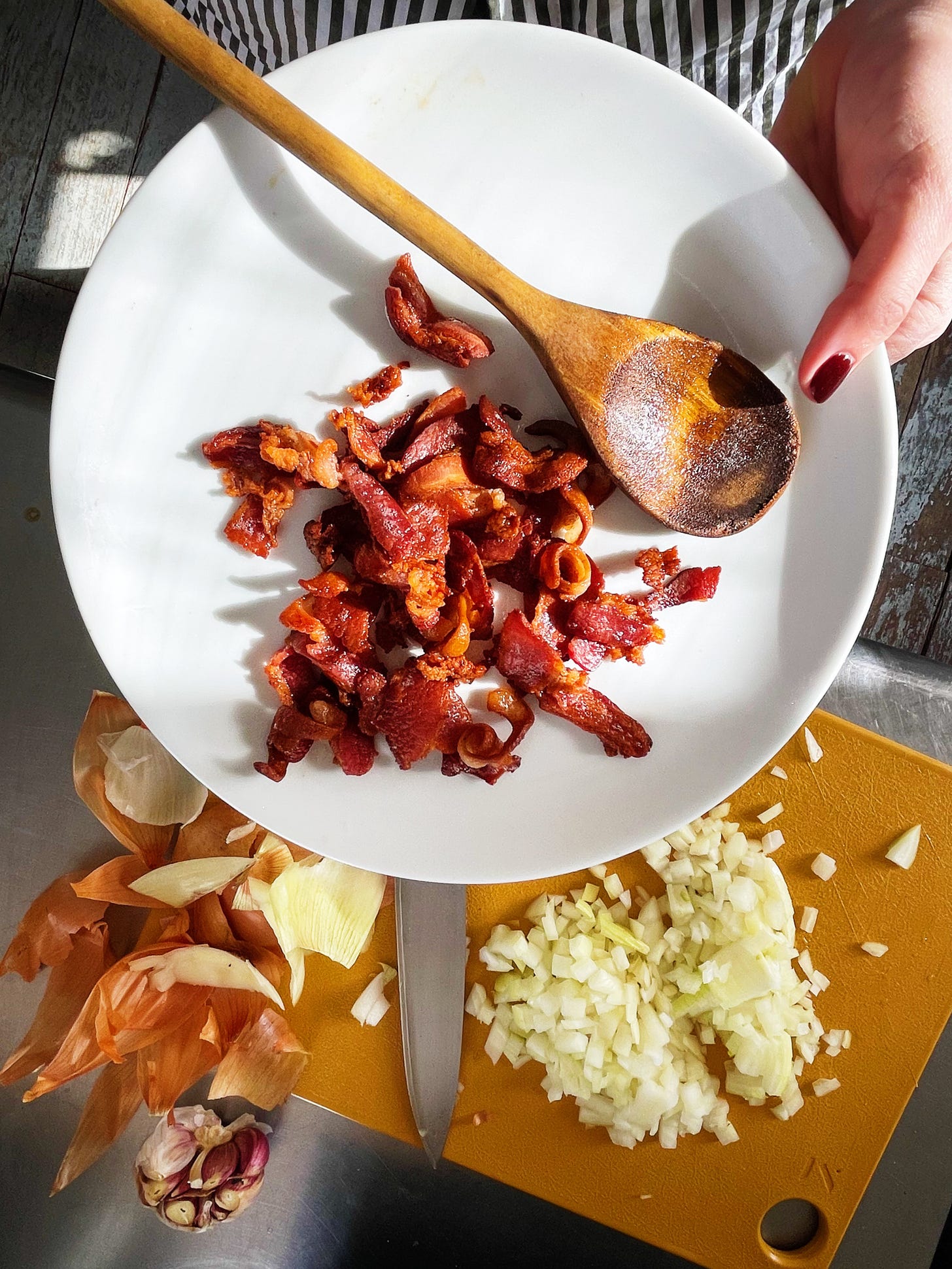Welcome to A Newsletter! Thank you for being here. If you’ve found your way over by some miracle but are not yet subscribed, let me help you with that:
What comes to mind when you hear “split pea soup?” Does it bore you? Fill you with apathy? Are you all of a sudden hungry? Does it make you want to cook a ham?
When I hear it, I think of eating dinner with my mom at a place deep in The San Fernando Valley called The Lamplighter (which, sadly, is no longer with us). In the grand tradition of San Fernando Valley “Family Restaurants” of the 90’s (see: Coco’s, Marie Callender’s), it felt more like a very large diner than a restaurant, with red leather banquettes, carpeted flooring and extremely bright lighting. The waitresses wore uniforms that matched the interior decor and I’m old enough to remember that there were, for a large time, smoking and non-smoking sections. What a world!
My mom and I would go here just the two of us, one of the rare mother-daughter rituals we had. She was a great cook and cooked often, but like all of us, sometimes “simply couldn’t,” and so she didn’t, and so, we went to The Lamplighter. She always ordered the same thing: split pea soup with rye toast, extra toasted. Everything was always extra toasted or extra crispy. Her fries, her toast, her bacon. The number of insufficiently toasted, crisped, griddled or fried things I have seen that woman send back could fill a book; nobody has ever met her standards when it comes to how crispy she really wants things, and I’ve got to give it up to her for never settling. While I would rather sink into a hole in the earth than ever send back food, it would be irresponsible not to acknowledge the obvious similarities, apple, tree, etc.
It was at The Lamplighter over two bowls of split pea soup with extra pepper on top and maybe a grilled cheese to share (extra griddled, please) where I told my mom that I had sex for the first time. My boyfriend (my best friend, a sweet boy!) and I had “been together” for a while. I was 16, it was bound to happen, sure, but she still cried. Was she sad? Upset? Did I disappoint her? Were they happy tears? Did my recent sexual activity remind her of her own mortality? I don’t quite remember how I told her or what I said, but I know that neither of us felt like eating split pea soup after that. Anyway, that’s what I think of when I think of split pea soup.

I’ve been house-sitting for two friends while they escape the cold and while I’m on a writing deadline. I was looking through their pantry for coffee filters when I came upon a bag of split green peas and thought immediately, I absolutely HAVE to make split pea soup, although it had been years since I’d had it and wasn’t even sure what I was craving. It was the first time my immediate thought was “I want to eat that” and not “wow, remember that time I told my mom I lost my virginity over a bowl of split pea soup?” Personal growth, maybe.
Inherently soft and mushy, split pea soup goes against a lot of my soup beliefs, and any attempt to change that (make tiny croutons!) feels like more effort than something like split pea soup should take. Give me one pot or give me nothing.
As for the texture, I let this soup become what it wants to become. Mostly soft but not without a semblance of its former self as a pea, with bits of tender, earthy rutabaga (please welcome “rutabaga” to the stage) swimming about (yes, you can use potatoes, sweet potatoes or carrots here, too). I, of course, will not under any circumstances be using a blender, handheld or otherwise.
While there aren’t any ground-breaking things I can point to to explain how this soup is different than what I’m sure one million split pea soup recipes look like, it does feel different to me. Probably because of the vegetable that is everywhere and nowhere, the humble and mysterious rutabaga*. Just kidding, probably because I don’t see it as a multi-hour, pressure-cooker, ham hock needing affair, something to be made only when the occasion (having a ham bone) arises. Probably also because of the bacon that isn’t cooked inside the soup but rather used only for its liquified fat and as a very crispy topping (who needs to make a crouton when you have crumbed up very crispy bacon), or maybe it’s the *kiss* of raw garlic at the end, helping the soup resist the urge to read as “sweet-ish”. Maybe it’s the aggressive sprinkling of bright, clean, green parsley: both predicable and optional.
If you’re making this without the pork products, simply cook your onions/garlic in 2 tablespoons olive oil. But what about the crispy parts? I would toast some panko or coarse breadcrumbs in that oil before adding onions and garlic for a crispy topping (see below). FWIW that would be good also even WITH the bacon (I would have taken a photo with the breadcrumbs AND bacon, but alas, I ate all the bacon. Chef’s treat!).
*If “cabbage” is any indicator, be prepared for an onslaught of rutabaga recipes, rutabaga lists and rutabaga hot takes to flood your feeds. Please stock up on rutabaga now!
Keep reading with a 7-day free trial
Subscribe to a newsletter to keep reading this post and get 7 days of free access to the full post archives.








